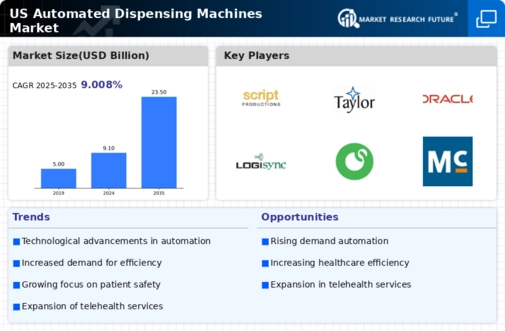The automated dispensing-machines market is currently characterized by a dynamic competitive landscape, driven by technological advancements and evolving consumer preferences. Key players such as KIOSK Information Systems (US), Crane Co. (US), and Seaga (US) are at the forefront, each adopting distinct strategies to enhance their market positioning. KIOSK Information Systems (US) emphasizes innovation through the development of customizable solutions tailored to various sectors, including retail and healthcare. Meanwhile, Crane Co. (US) focuses on expanding its product portfolio through strategic acquisitions, thereby enhancing its operational capabilities and market reach. Seaga (US) appears to be concentrating on digital transformation, integrating advanced software solutions into its dispensing machines to improve user experience and operational efficiency. Collectively, these strategies contribute to a competitive environment that is increasingly focused on technological differentiation and customer-centric solutions.
In terms of business tactics, companies are increasingly localizing manufacturing to reduce lead times and enhance supply chain resilience. This approach is particularly relevant in a moderately fragmented market where agility can provide a competitive edge. The collective influence of these key players shapes a landscape where innovation and operational efficiency are paramount, allowing them to respond swiftly to market demands and consumer trends.
In October 2025, KIOSK Information Systems (US) announced a partnership with a leading healthcare provider to deploy automated dispensing solutions in hospitals across the Midwest. This strategic move is likely to enhance patient care by streamlining medication distribution, thereby positioning KIOSK as a leader in the healthcare segment of the market. The partnership underscores the growing importance of automation in improving operational efficiencies within healthcare settings.
In September 2025, Crane Co. (US) completed the acquisition of a European-based technology firm specializing in AI-driven vending solutions. This acquisition is expected to bolster Crane's capabilities in integrating artificial intelligence into its product offerings, potentially revolutionizing the user experience and operational analytics of its dispensing machines. The strategic importance of this move lies in its potential to enhance Crane's competitive edge through advanced technology integration.
In August 2025, Seaga (US) launched a new line of eco-friendly dispensing machines designed to reduce energy consumption by 30%. This initiative aligns with the growing consumer demand for sustainable solutions and positions Seaga as a forward-thinking player in the market. The strategic importance of this launch is underscored by the increasing regulatory pressures and consumer expectations surrounding sustainability, suggesting that Seaga is proactively addressing these challenges.
As of November 2025, the competitive trends in the automated dispensing-machines market are increasingly defined by digitalization, sustainability, and the integration of AI technologies. Strategic alliances are becoming more prevalent, as companies seek to leverage complementary strengths to enhance their market offerings. Looking ahead, competitive differentiation is likely to evolve from traditional price-based competition to a focus on innovation, technological advancements, and supply chain reliability. This shift indicates a market poised for transformation, where the ability to adapt and innovate will be crucial for sustained success.























Leave a Comment